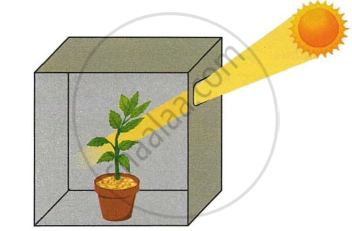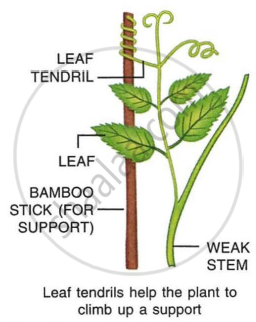Advertisements
Advertisements
प्रश्न
The figure given below depicts a kind of tropic movement in plants. Study the same and answer the following questions:

- What kind of a movement is shown in the figure? Define it.
- How does this movement differ from geotropism?
- Name the stimulus responsible for thigmotropism. Give one example of a plant showing thigmotropism.
- Name one stimulus which gives a positive response for the roots but a negative response for the shoot.
- Draw a neat and labelled diagram of the part of a plant showing leaf tendril. Name the plant.
उत्तर
- Phototropism is shown in the figure.
A plant's bending in a direction of light is a phenomenon known as phototropism. - The response to the stimulus of light is known as phototropism, while geotropism is a response to the stimulus of gravity.
- The stimulus responsible for thymotropism is touch.
Cuscuta and vine tendrils coil around other plants or a support to create a one-sided touch or contact. - Gravity
- Sweet pea plant shows thigmotropism. The labelled diagram showing leaf tendril is given below:

संबंधित प्रश्न
How does phototropism occur in plants?
Plant parts show two types of movements, one dependent on growth and other independent of growth. Give one example which does not depend on growth
Name the plant part which bends towards light but away from the force of gravity.
The movement of a plant part in response to the force of attraction exerted by the earth is called :
(a) hydrotropism
(b) geotropism
(c) chemotropism
(d) phototropism
A growing seedling is kept in a dark room. A burning candle is placed near it for a few days. The top part of seedling bends towards the burning candle. This is an example of :
(a) chemotropism
(b) hydrotropism
(c) phototropism
(d) geotropism
The bending of the root of a plant away from a source of light is caused by a plant hormone called :
(a) cytokinin
(b) gibberellin
(c) abscisic acid
(d) auxin
The movement of a shoot towards light is:
Plants take in carbondioxide for photosynthesis but need ______ for their living.
When the leaves of the Mimosa pudica plant are touched with a finger, they fold up quickly.
______ of sweet peas exhibit thigmotropism.
